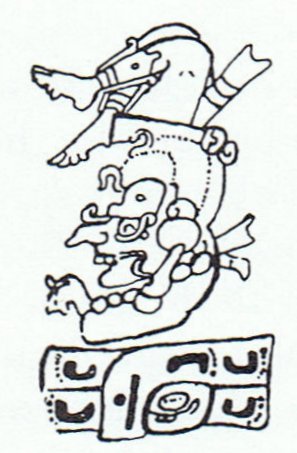|
TRANSLATIONS
Let us return to the Rain God locations. The colours of the months are due to the effects of sun and rain together, creating a rainbow. The Rain God, I suspect, is just the Sun God seen from another perspective. There are 13 locations (presumably also regarded as months) for the sun ('Rain God'). We have visited 4 of them: tree, ocean, eagle, and crossed bones:
Can we put them in the proper time order? We have one fixed point to rely upon - the crossed bones, the season when sun has left us. The eagle probably resides at midsummer and the tree at midwinter. The ocean might be an inundation coming after crossed bones, but we cannot be certain. Before we add the remaining 9 localities, we must straighten out the order of the locations according to Kelley, because he does not use the order in Dresden:
For some reason, not documented, Kelley has numbered the locations in another order than that in which they are presented in Dresden. I will rely on Dresden in the following, which presents the localities in groups of 3 (with the 13th and last in D69b). The first group (D65b) has these localities:
"The association of the cab 'earth' glyph with the god in a canoe is puzzling. The alternate glyph for this locality is imix (identified as a water lily, Yuc. naab) with 'in' prefixed." Kelley seems to have other sources which he refers to. I cannot see any imix glyph or water lily. But the water dragon below the canoe must surely be imix. The caban sign (right in the glyph) could mean that we are entering the 'earth' domain, which has Imix at its beginning:
The first part of the glyph looks like the bottom part of Zip:
The top part of Zip could mean inverted red, cfr Ceh, maybe the red of dawn instead of the red of deer:
The amphibian is moving from ocean to land. The first station apparently is somewhere in the region of Zip and Zotz. The Rain God is a baby arriving in a 'canoe', being delivered in the reeds like Moses. The month calendar begins at new year, but the Rain God stations apparently begin with the arrival of summer. We will see if that is a correct suggestion. Next station, number 2, shows the Rain God with his feet and his residence as if in a spooky state: "The second locality is regarded by Barthel as 'sand'; the graphemes are unexplained." Following the Aztec guidance I would rather say that the residence is 'wind', which of course explains why we can see only emptiness. Sand is though not a bad suggestion, because the canoe will land on a sandy beach. The Rain God is carrying under his arm a two spears, I think, which could agree with Aa1-3--4:
The right bottom part of the glyph looks like an eagle - which of course inhabits the air. The right top part looks like the sign for tying up, and the winter season needs to be tied up. The line around the sun eye 'iris' is not drawn more than as a dots - sun is not present. The 3rd station has footprints (in the sand?): "The third locality is the place of footsteps (T585:186). Knorozov (1955a, p.87, no. 139) has read T585 as col 'field' and T186 as tah, making the whole read 'cultivate the field', a phrase that has no relevance in this context. Thompson's identification of T585 as bix, a numerical classifier, seems sound; proto-Maya bix is apparently 'dance', and I am inclined to regard this glyph as meaning 'place of dancing'. It should be noted that it has the 'in' prefix. The fact that the footprints are shown going in opposite directions and turning back upon themselves may support this view somewhat. This would indicate that T186 is some sort of locative suffix, probably corresponding more to our 'place of' than to our 'at'." Here Kelly makes it difficult for us again. Those footprints going in opposite directions are not to be seen. He may have looked at another picture, viz. one of those in his figure 36 ("Isolated localities of the Rain God"):   Neither the picture nor the glyph agree with the 3rd location. We can dismiss Kelley's suggestion of a dancing place. Knorozov's idea is more sound. When the explorers had landed their first tasks were to CuLtivate fields and erect a house. Is the Rain God working with a digging stick? What is that other object tucked in under his arm? Is it a bag with seed? |
|||||||||||||||||||||||||||||||||||||||||||||||||||||||||||||||||||||||||||||||||||||||||||||||||||||||||||||























